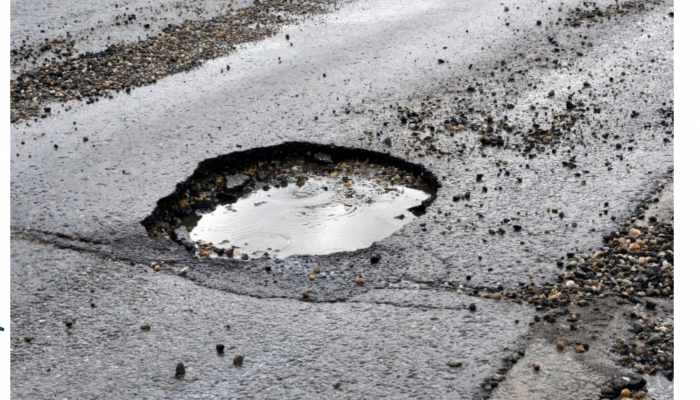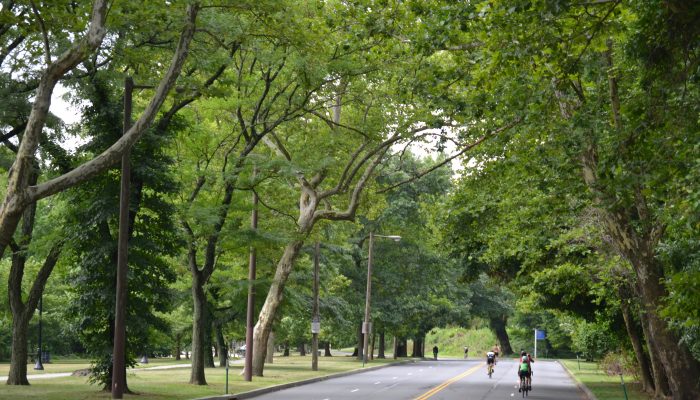Pesky, painful, problematic, pitiful – potholes can be described in way ways, but hopefully this explanation leaves you less perplexed in identifying the most commonly reported roadway defect, and getting it fixed.
The Streets Department distinguishes three major roadway defects: potholes, ditches and cave-ins, because the way each one is formed is substantially different. This would mean the repairs are very different too.
How do potholes form?
Potholes are bowl-shaped openings that usually have raveled edges and can be up to 10 inches deep. They occur when the top layer or asphalt has worn away, exposing the concrete base.
A combination of rain, or iced-roadways in winter, quick changes in temperature and weather, consistent salting and plowing, the amount of time since the roadway was last resurfaced and heavy traffic can contribute to cracks in the road surface. Rainwater seeps into those cracks, and expands during freezing and thawing weather. It causes swelling which wears away the top two layers of the surface. The stressed surface crumbles under tires and forms a pothole.
Repairs to potholes can often occur within a few days but depends on the severity of the problem and the weather. The best time for pothole repair is a dry day when the temperature reaches at least 40 degrees. The City deploys the repair crews and pothole patcher machines to repair potholes.
Not quite a pothole, maybe it’s a ditch…
Unlike potholes, ditches are rectangular excavations in the roadway and cut purposely using straight lines, and straight edges. These cuts are made by utilities and plumbers to reach underground lines. The contractors are responsible for filling the ditch and paving it temporarily, and notifying the city upon completion of their work. The Streets Department then schedules a permanent repair to the roadway. If a ditch is not backfilled properly, it will wash out or sink in, leaving a deep hole.
The process for repairing a ditch may require more time and depends heavily on when it is reported by the contractor. Residents should report ditches that have been washed out, leaving behind a deep hole.
Are cave-ins and sink holes the same thing?
Cave-ins (sometimes called “sink holes”) are holes that reach past the concrete base of the roadway. This void can occur when the dirt below the concrete base has washed away, causing the upper surfaces to fall through. Before a cave-in is repaired, crews inspect the defect to determine if there is an underlying cause. The subsurface is then repaired and may require work by property owners and/or utility agencies (Water Department, PGW, PECO, cable utilities).
What should I do if I see a roadway defect?
While it would be great if they did, the truth is pesky potholes and other roadway defects don’t fix or report themselves. The Streets Department relies on resident reporting to determine location of the problem and its features. Reporting what’s observed early-on, results in less long-term break-down and damage of the street surface.
Here’s what the Department needs to know…
- Give the exact location (address).
- Describe the hole.
- Is the hole on the sidewalk or roadway (driving lane or parking lane)?
- Size (approximate length/width/depth).
- Is there is a barricade over this hole?
- Note whether you hear or see water in the hole.
- Is this on a bus route?
- Is the hole in a trolley track area?
Potholes found on major roadways, other than state highways, and potholes that are an immediate hazard to motorists or pedestrians, are given primary attention. Repair crews will fill all potholes encountered, and make safe any ditch that requires a repair in each section assigned.
If the pothole location you report is on a state-maintained street, the Streets Department will inspect this location, and forward your request to the Pennsylvania Department of Transportation (PennDot) on your behalf. If you would like to follow up on your request or for additional information on state streets, contact PennDot at 1-800-FIX-ROAD (349-7623) or at @511paphilly on Twitter.
Potholes found inside trolley tracks and 18″ on either side are serviced by SEPTA. The Streets Department will inspect this location and forward your request to SEPTA on your behalf. If you would like to follow up on your request or for additional information on SEPTA services, you may contact SEPTA Customer Service at (215) 580-7852 or visit their website.




